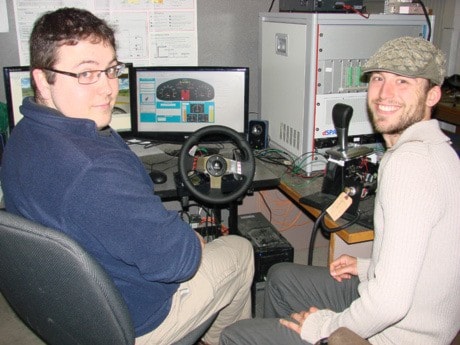In a windowless cement bunker of a building on the north end of the University of Victoria campus, Stefan Kaban boots up a computer.
On one of two screens is a computer-generated split image of a car traveling a landscape. With a steering wheel attached to the computer table, a set of pedals on the floor and a stick shift at hand, the first question is: how do we rack up points in this game?
“This is not a game,” says Kaban, a masters mechanical engineering student. “This is software.”
It’s the first year of the design competition for EcoCar 2, the three-year competition sponsored by the North American auto industry that aims to flush out talented, young, potential auto designers.
It’s the second time around for a University of Victoria’s team, which placed second, fourth and eighth in the first competition, which ended in early 2011. With that project, a 2009 Saturn Vue hybrid had its transmission modified. Except for Kaban, all those team members have graduated from UVic. Nine of them are working in the automotive industry.
Under the supervision of engineering chair, Zuomin Dong, this time around Kaban is leading a team of 20 volunteer undergraduates on re-jigging a 2013 Chevy Malibu, donated by General Motors Canada.
The overall mandate of the competition that attracts teams from 16 universities across North America is simple: how do you reduce the energy impact of a vehicle?
Being a group of young men, UVic’s team focus is on increasing power in the hybrid Malibu.
“Part of our challenge is that there are a lot of things you can do to design a car that uses very little fuel but people have come to expect some comforts, features that if you took them away, would make it less attractive to sell.” Hybrid cars of today are designed purely to reduce fuel consumption, Kaban says.
Hybrid batteries have a maximum distance of 30-60 kilometres before they need recharging. The UVic team intends to increase that to 350 km, using two electric motors, one in the rear and one in the front of the car, and bigger batteries. That is challenging in a car in which every square centimetre is already designed for maximum use.
Dong said the EcoCar 2 project has provided the department with “the golden opportunity to apply advanced hybrid vehicle powertrain research to an industrial application, and to allow our students at all levels to obtain advanced training on cutting edge automotive, mechatronics, computer system and green vehicle technologies and to become the specialists and future leaders of green vehicle technology.”
Kaban and the team are keen to present the design they’ve been working on for the past eight months in the preliminary competition set for this week in Los Angeles. The plans are only on paper at the moment – physical changes to the Malibu will start this summer after considering judges’ recommendations. Kaban also notes there are other reasons for taking part in the test.
“These (sponsors) are also the people that will give you a job. You want to show them you’re capable of doing this work.”
To learn more about the EcoCar 2 project go to ecocar2.uvic.ca.
